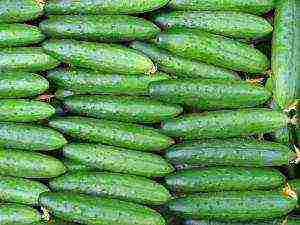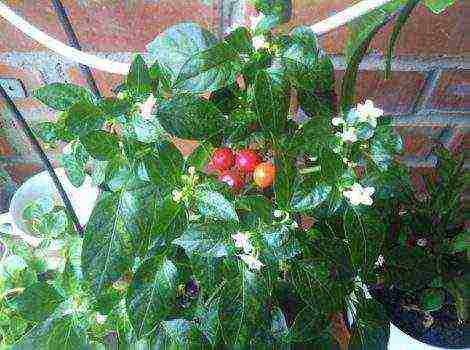Content
- 1 Varietal variety of cucumbers
- 2 The most popular varieties with names
- 3 How to choose the right seeds for open field cucumber?
- 4 How to prepare cucumber seeds for outdoor planting?
- 5 How to plant seeds?
- 6 Two ways of sowing cucumbers - take note of both!
- 7 What are the best cucumber seeds - gardeners' opinions
- 8 Cucumber seeds - the purpose of varieties
The success of the cucumber crop depends in particular on the choice of seed. The wide assortment on the shelves confuses thoughts rather than allows you to make the right decision. Novice gardeners are advised to first familiarize themselves with the varieties, their names, the characteristics of cultivation and care.
Depending on climatic conditions, different varieties can be planted in Ukraine, Belarus, Chernozem, Bashkiria and the middle lane - these can be parthenocarpic, early ripening, with a long ripening period, or delicious cucumbers for growing in a greenhouse. More information is structured in the article in the form of a kind of list-rating.
Varietal variety of cucumbers
A large number of varieties allows you to choose the best options that have disease and weather resistance the region where the green plant is planned to be grown.
A common mistake is the use of certain 2-3 varieties, the cultivation of which has been practiced for several decades.
Domestic and foreign breeders have developed many hybrids that have no less affordable agricultural technology and excellent taste than the once loved cucumbers.
Among the top tips for growing vegetables, experts point to the need to plant several varieties at once... This makes it possible to evaluate the yield of different species under the same ripening conditions, to get at least some yield during drought or prolonged rains.
Collect the necessary and useful information about the varietal variety, the characteristics of the characteristics of zelents can be found below.
The most popular varieties with names
For the convenience of perception and application of the text in practice, plants are divided into separate groups, united by a common feature.
The best self-pollinating for outdoor use
Self-pollinating cucumbers have a number of advantages, among which excellent immunity and resistance to an abundance of moisture are noted.
- Booth - ripening period is only 40 days. The length of the green plant reaches 9 cm. One bush yields up to 3.5 kg. The strong immunity of the plant resists various diseases (olive spot, mosaic, powdery mildew).
- Courage - harvesting of the Kurazh variety begins 40-47 days after the sprouts break through from the soil. The weight of one cucumber reaches 170-180 gr., Up to 10 zelents are formed on one shoot. The plant practically does not suffer from rot, powdery mildew.
- Connie - harvesting of fruits begins on the 50th day after sowing. The culture is universal both in the way of cultivation and in the use of cucumbers. The length of the greenery is 10 cm, the yield from 1 m2 is about 9 kg.
- Berendey - fruits (12-15 cm) ripen 42 days after the emergence of sprouts. One bush can be harvested up to 3.5 kg. Zelentsy have excellent characteristics and have a long shelf life.
- Gerda - fruits 10 cm long appear 1.5 months after sowing. 2.8-3 kg are removed from the bush. The plant is rarely affected by diseases; it is especially resistant to fungal infections.
The best early ripe cucumbers
Early ripening varieties have a feature that every gardener should be familiar with.
The ovaries of male flowers are the first to form, they must be removed, since they interfere with the development of the plant.
- April - from the moment of planting, the fruits of April ripen on day 50, reaching a length of 20-22 cm. The plant itself regulates the growth of shoots, so the need for pruning disappears. Productivity from 1 m2 on average 22 kg. Cucumbers do not overripe if they miss the assembly deadline. The culture is resistant to almost all diseases, with the exception of root rot.
- Hermann - sprouts at 39-41 days after sprouting. The length of Herman's greens reaches 10 cm, 23-26 kg are harvested from 1 m2. The hybrid is characterized by a long fruiting period, self-pollination and immunity to fungi.
- Orlik - begins to bear fruit on the 47-50th day after sowing. The length of the greenery reaches 14-16 cm, with a diameter of 3.5-4 cm. 6-8 kg are removed from the bush. The culture has a strong immunity, resists powdery mildew, root rot, olive spot and TMV.
- Valdai - the bush begins to bear fruit on the 45th day after the emergence of sprouts. Flowers are formed predominantly by women, therefore pollination by bees is required. The length of the greenery is about 10-11 cm, up to 4.5 kg of the crop is removed from the bush. The hybrid was developed for preservation, but due to its delicate taste it is also used for salad.
Mid-season
Medium ripening varieties begin to bear fruit on the 45-55 day after sowing the grains into the soil. All plants of this group differ in the method of cultivation (greenhouse, soil), purpose (fresh or for salting) and the type of pollination.
- Competitor - characterized as a plant that loves life and is resistant to diseases. The length of the greenery reaches 9-12 cm with an average weight of 100 grams. Up to 3.8 kg of the crop is harvested from each m2. The variety has good immunity and is resistant to powdery mildew.
- Nezhinsky - a variety pollinated by bees, characterized by a powerful stem, medium-sized fruits (length 10-12 cm, weight 90 g) and high yield (8 kg per 1 m2). Nezhinsky tolerates low temperatures and is resistant to many diseases. Cucumbers have a high taste.
- Libella - a versatile hybrid with a long fruiting period. With proper care, you can harvest until the coldest days. The length of the Libelle greenery reaches 14 cm, weight - 140 grams. Up to 10-12 kg are removed from a square meter. When salted, the flesh remains crispy and firm. In agricultural technology, there are rarely cases of damage to crops by common diseases.
- Table - has an excellent taste without bitterness, ideal for salting. The bush is formed long with a strong whip, the length of the fruit reaches 12 cm and weighs 80-90 grams. Productivity from 1 m2 about 8 kg.
Late ripening
A feature of late-ripening cucumbers is that the seeds germinate well only in the 3rd year.
Therefore, the purchased material before planting is worth check for germination... Also, when choosing varieties of this group, you need to take into account the climate of the region and the ripening period of zelents in order to have time to collect most of the harvest before the onset of cold weather.
- Phoenix - the harvest period begins 64 days after seed germination. Cucumbers reach a length of 16 cm, with an average weight of 230 g. Phoenix bushes form a branchy whip that resists the vagaries of the weather well.
- Winner - differs in long spreading lashes that easily tolerate drought, coolness. The plant is resistant to various types of fungi. Fruit length reaches 14 cm with an average weight of 110 grams. The yield from 1 m2 is 7-8 kg.
- Solar - the variety is mid-season, but most gardeners plant it as late. The bush produces many twigs, forming a massive whip, which implies planting in a large area. The peel of the greenery is covered with a few tubercles and greenish stripes. The length of a cucumber reaches 12 cm with an average weight of 140 grams.
- Brownie - the harvesting period begins 65 days after germination. The length of the cucumbers is small (9 cm), but the taste is high.The culture has good immunity, showing resistance to almost all common diseases. Productivity - 6-8 kg per 1 m2.
- Chinese - a disease-resistant variety with a mild taste and lack of bitterness. A feature of the fruit of the Chinese cucumber is considered to be a short shelf life after harvest. Original elongated cucumbers (30-35 cm) look like snakes. The plant tolerates low temperatures and poor lighting well.
Which are the highest yielding for greenhouses
All gardeners, without exception, are attracted by high-yielding varieties. In your greenhouse, you can try to grow the most popular ones.
- Parisian gherkin - fruits ripen in 50-60 days after sowing. The length of the Parisian gherkin variety reaches 12 cm with an average weight of 85 grams. A large number of ovaries are formed on the lash, which guarantees a high yield - over 30 kg per 1 m2. Low germination of seeds provides for planting beds through seedlings.
- Fontanelle - a popular cucumber among gardeners in our country. It is grown in almost every area. The dimensions of the Spring greens reach 22-24 cm with an average weight of 150 grams. More than 10 kg are removed from the bush. In terms of taste and rules of agricultural technology, the variety remains competitive in front of the best European developments of breeders.
- Zozulya - the harvesting period begins on the 45th day after sprouting. The formation of the lash is carried out in such a way that the bush does not need pruning. Zelentsy reaches 24 cm in length with an average weight of 280-300 grams. From a square meter, you can collect up to 30 kg of Zozulya cucumber. The plant is practically not sick with olive spot and cucumber mosaic.
For planting outdoors
- Suzanne - a versatile crop that can be grown not only in the open field, but in a greenhouse and even on a balcony. The length of the lash reaches 3-4 m, forming a large number of ovaries. Picking 3-4 centimeters fruit or wait until they become larger, this does not affect the taste. Suzanne has good disease and pest resistance.
- Sparta - the hybrid is bee-pollinated with stable fruiting. The length of the greenery is 6-12 cm, the taste is pleasant without bitterness. The culture has a strong immunity, especially against powdery mildew and fungi. The yield per bush is 2.8-3.1 kg.
- Pickle - the fruiting period begins 55 days after the emergence of sprouts. The length of the greens is 9-11 cm with an average weight of 100-110 grams. More than 4 kg are removed from one bush. The pickle has a delicate taste with a sweetish note, without bitterness.
- Pinocchio Is a self-pollinated hybrid that begins to ripen 48 days after germination. The length of the greenery is about 8-9 cm with a weight of 85 grams. The yield per bush is 3.4 kg.
- Sturdy - by the rate of ripening, the cucumber is considered a sprinter, just 38 days after the emergence of sprouts. The length of the greenery is about 9 cm with a weight of 80 g. The fruiting period is fleeting, all ovaries form and ripen together. Unfavorable weather does not have a negative effect on the growing season.
For growing in Siberia
Growing cucumbers in a harsh climate has its own characteristics. It is better to plant cucumbers in Siberia in polycarbonate greenhouses or choose fruitful early maturing varieties.
When choosing seeds, preference should be given to varieties that are resistant to stress.
- Altaic - it has a short ripening period, the harvest begins 36-40 days after germination. The length of the greenery is 9-12 cm with a weight of 100 g. The plant is cold-resistant, easily tolerates the vagaries of the weather. After harvesting, the fruits retain their presentation and taste for a long time.
- Serpentine - gherkin type cucumber, ripens 39-42 days after germination. The fruiting period is intense, already in the first 10 days most of the harvest is harvested - over 1.7 kg per 1 m2. Serpentine is known for its taste, which lacks bitterness.
- Bush - a compact plant that needs pollination.The length of the greenery reaches 8 cm with a weight of 90 grams. Productivity is stable with proper care (3 kg per bush). The peculiarity of the variety is its endurance and strong immunity. Cucumbers are versatile.
Each variety of cucumbers has a range of impressive benefits. The main thing when choosing is to take into account the climatic features of the region and the correspondence to them of the characteristics of the varieties you like. Then the main stage of laying the future harvest will be performed correctly.
To get a high yield, fertilized soil and constant maintenance are not enough. It is also necessary to pick up quality seeds. What kind of cucumber to plant outdoors? What should a summer resident know about preparation and planting and how to choose the right cucumber seeds for open ground?
Of the hybrids that are great for open ground, it is worth noting the following varieties:
- Eliseevsky;
- Arkhangelsky;
- Novgorodets;
- "Leader";
- "Well done";
- "Paratunka";
- "Road";
- "Take a walk";
- "Boyfriend";
- Twixy;
- "Mikhalych";
- "Gypsy";
- "Passat";
- "DF Svyatoslav".
The cucumber variety "Advance" (pollinated by bees) also gives a good yield, but it is not suitable for salting. A hybrid "Svyatoslav" can be planted especially for this.
How to choose the right seeds for open field cucumber?
In order not to miscalculate with the variety, it is worth paying attention to whether it is intended for cultivation in greenhouse conditions, on covering soils or in open soil. After all, for example, sown greenhouse types of cucumbers will not be productive in open soil.
How to choose the right seeds for open field cucumber? - It is worth determining the goal - to grow gherkins, cucumbers for pickling and pickling or salads.
Salad cucumbers will be perfectly stored in the refrigerator, they may darken a little, but when salted they will simply turn sour. Salted varieties are strong, remain crisp and green in brine. Gherkins are a good choice for both salad and canning.
Breeders have developed universal varieties that have all of the listed properties:
- Santana F1;
- Regina F1;
- Dachny;
- Crane F1;
- Gracious;
- Farmer.
If you want to feast on canned cucumbers, you should opt for:
- Nezhinsky variety;
- Muromsky (early ripening old variety);
- Fontanelle;
- Magnificent;
- Salting;
- Swag F1;
- Atlantis F1.
Among the gherkins, preference should be given:
- "Nunhems".
- Sparta F1.
- Hector F1.
- Delpine F1.
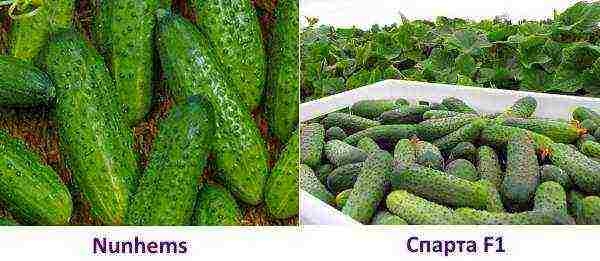
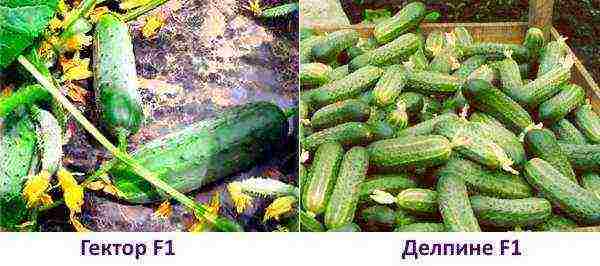
What are the pick-up seeds of cucumbers for open ground (self-pollinated) and what is the advantage of such varieties?
- The fruits are set without pollination by bees.
- They give high yields.
- They are characterized by high-quality greens.
- Cucumbers have no bitterness.
- They bear fruit constantly.
- They are characterized by high resistance to weather changes, as well as to diseases.
Self-pollinated cucumber seeds are popular, such as:
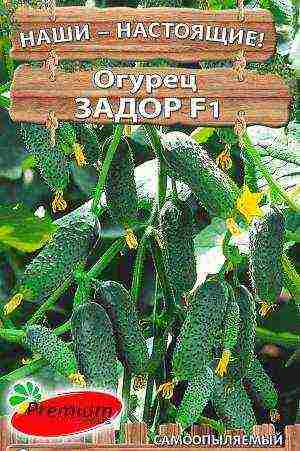 F1 Zador - dark green gherkins grow with whitish pubescence, have a cylindrical shape, length up to 10 cm. The variety is early and suitable for canning, since it has a thin skin. There are no seeds, which prevents the formation of voids during salting. You can grow by sowing in open ground or planting seedlings.
F1 Zador - dark green gherkins grow with whitish pubescence, have a cylindrical shape, length up to 10 cm. The variety is early and suitable for canning, since it has a thin skin. There are no seeds, which prevents the formation of voids during salting. You can grow by sowing in open ground or planting seedlings. F1 Picas - these seeds give a high yield. It is a mid-season variety (55 days). If planted in open ground, the first time is covered with a film. Fruit length - up to 20 cm, weight - 200 grams.
F1 Picas - these seeds give a high yield. It is a mid-season variety (55 days). If planted in open ground, the first time is covered with a film. Fruit length - up to 20 cm, weight - 200 grams.
It is characterized by resistance to rot and powdery mildew.
It is not suitable for salting, but for a salad it is a great option. Raphael F1 is a high-yielding mid-season variety (50 days) with a shoot length of up to 3 m. Seeds are sown in May and seedlings are planted in June. One knot can contain 2 ovaries. The cucumber reaches a length of 20 cm. Not suitable for pickling.
Raphael F1 is a high-yielding mid-season variety (50 days) with a shoot length of up to 3 m. Seeds are sown in May and seedlings are planted in June. One knot can contain 2 ovaries. The cucumber reaches a length of 20 cm. Not suitable for pickling.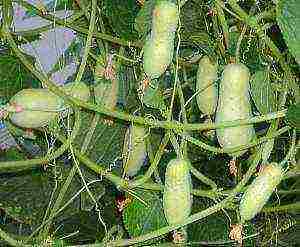 White Angel F1 is a mid-season variety characterized by a high level of self-pollination. The bosom of each leaf can contain 2 ovaries. Fruit - up to 8 cm, has infrequent tubercles. Suitable for salad and pickling. Up to 4 kg of cucumbers can be harvested from one bush. It bears excellent fruit at a temperature of 18 - 24 degrees.
White Angel F1 is a mid-season variety characterized by a high level of self-pollination. The bosom of each leaf can contain 2 ovaries. Fruit - up to 8 cm, has infrequent tubercles. Suitable for salad and pickling. Up to 4 kg of cucumbers can be harvested from one bush. It bears excellent fruit at a temperature of 18 - 24 degrees.
How to prepare cucumber seeds for outdoor planting?
Before preparing cucumber seeds for sowing in the open field, it is worth figuring out how to choose them.
- To achieve a plentiful set of cucumbers, you need to plant seeds that are at least and no more than two to three years old. Seeds can sprout in 10 years, only the yield will be minimal, just like when planting annual seeds.
- If you only have planting material that is no more than a year old, proper preparation of seeds for planting in open soil is a prerequisite to guarantee a high yield. A prerequisite for storage is to provide access to heat (for example, near a battery). 30 degrees will be enough. On the eve of the summer season, the seeds are heated at a temperature of 50 degrees for 3 hours.
- Seeds 2 - 3 years old should be stored in cloth or paper bags in a warm place with minimal moisture.
- For planting, the seeds need to be prepared. To do this, they are soaked for 2 hours in water, calibrated (40 g of salt per 1 liter of water is mixed), where they are kept for about 20 minutes. Further, full-weight seeds are selected, and the weak ones are thrown away.
Then they are warmed up: in a cloth bag, the seeds are dipped for a couple of hours in a thermos, the water in which should reach 50 degrees.
How to prepare cucumber seeds for outdoor planting to prevent the development of diseases and fungi?
- It is worth disinfecting with potassium permanganate for half an hour, after which the seeds are washed. Processing can be dry or wet. If you chose the second method, then after the procedure it is worth drying the planting material.
- The next stage - the seeds are enriched with useful substances. To do this, they are immersed in a solution of wood ash (2 tablespoons of ash per 1 liter of water at room temperature) for 3 hours. Then washed again.
- To speed up the germination of seeds and protect them from rot, they are soaked in a solution of 1 tsp. copper sulfate and nitrophoska for 12 hours. To improve the immunity of the fruit, the seeds are soaked in a solution of aloe juice and water (1: 1). Another option for hardening is to place the germinated seeds in the cold for a couple of days.
- The processed seeds wrapped in a damp cloth or bag will root after 2 days. Do not wait for a large root to grow back, or it may break off when disembarking.
How to plant seeds?
First, the seeds are tested for germination. To do this, they are immersed in cool water for 12 hours, which is periodically changed. Then the seeds are taken out onto a damp cloth. It is necessary to provide conditions for germination - light, temperature and humidity should be optimal.
When the seeds begin to germinate, it will become clear which are suitable for sowing and which are not.
Prepare your garden before planting cucumber seeds outdoors. If you plan to plant seeds without further replanting, then drill sowing is used. Then you should follow these steps:
- Deepen the bed with a hoe (5 cm).
- Seeds are sown into the grooves, leaving approximately the same distance between them (which will depend on the selected variety).
- The soil is tamped and watered.
Cucumbers do not like the cold, so it is worth planting seeds in warm soil on the sunny side of the site, where there are no winds. To protect the soil from drying out (and therefore to provide favorable conditions for seed germination), it is worth covering the ground with a film.
If you plant seedlings, you will get the harvest a couple of weeks earlier. For breeding seedlings, substrates that contain peat are used.
Top dressing is carried out at the root of the sprout. Use non-concentrated water-soluble mineral fertilizers every 7 days. You can water with water at room temperature.
This overview of the best open field cucumber seeds will help you get high yields even from a small planted area, since you can't go wrong with the variety you choose.
Video about choosing seeds for open ground
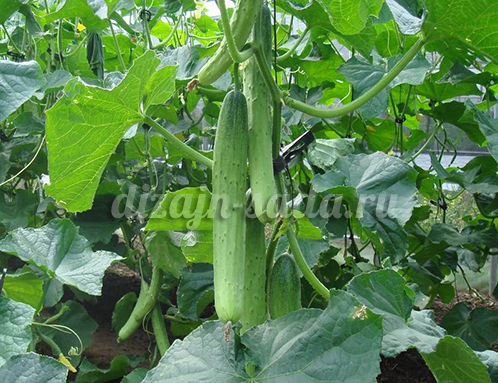
cucumber April F1
Using my many years of experience in growing cucumbers in a greenhouse and open field, as well as having studied the reviews of other gardeners on the forums and numerous neighbors in the garden, I can confidently advise you to plant the best varieties and hybrids of cucumbers. They are suitable for growing both in greenhouses and under temporary cover films and in open ground. Each gardener chooses what suits him best.
Of course, for a greenhouse, it is better to take hybrid varieties of F1 cucumbers, since they have short side lashes and do not need to be pinched. Hybrids tend to have high yields and disease resistance.
If you choose varieties of cucumbers for the Urals and Siberia, then consider varieties and hybrids that bear fruit well in low light conditions and are cold-resistant.
If you plant cucumbers in a greenhouse or greenhouse that require pollination by bees, do not forget that from the beginning of flowering, bees should have free access to flowers.
Cucumber varieties with photos and descriptions, reviews
Cucumbers Herman F1
An early, high-yielding parthenocarpic hybrid with a long fruiting period. The plant is powerful, with sufficient nutrition it simultaneously forms up to 6-7 fruits in one node. Fruits are green, dense, large tuberous, gherkin type, genetically without bitterness.
The hybrid is resistant to cladosporia, powdery mildew and cucumber mosaic virus. It is grown both in greenhouses and in the open field in vertical and horizontal ways.
Productivity of cucumbers Herman: up to 9 kg per plant per season (subject to timely watering and feeding).
Cucumbers Masha F1
The earliest (37-39 days before fruiting), parthenocarpic hybrid. The fruits are standard in size, 8-11 cm long, ripen together, have a very attractive appearance. They are good both fresh and salted.
The hybrid is resistant to cucumber mosaic virus, cladosporiosis, powdery mildew, relatively resistant to downy mildew.
Productivity of cucumbers Masha: more than 10 kg of fruits per 1 sq. meter of landings.
One of the most beloved cucumbers.
Cucumbers Connie F1
An early high-yielding parthenocarpic (not requiring pollination) hybrid of the gherkin type, 43-45 days pass from germination to the beginning of fruiting. The plant is medium-growing, with a bundle formation of ovaries.
Cucumbers are short, cylindrical, 7-9 cm long and weighing 60-80 grams, bright green, small-tuberous, white-thorn. Crispy, juicy, without bitterness, with excellent taste. The hybrid is resistant to overgrowth, powdery mildew and root rot.
Connie F1 is a multipurpose cucumber used for fresh consumption and for processing. Recommended for growing in open and protected ground.
Connie's cucumber yield: 14 - 16 kg / m².
Cucumbers Courage F1
Early ripening parthenocarpic hybrid (from germination to fruiting 45-50 days), female flowering type, intended for cultivation in greenhouses.
The plant is vigorous, with medium shoots. In the nodes, 2-4 ovaries are formed (often up to 5-6 ovaries).
Fruits are dark green with light stripes, 12-15 cm long, weighing 120-130 grams, lumpy, white-thorn, universal use. Taste quality is high, without bitterness. Planting density 2.5-3.0 plants per sq. meter. The hybrid is relatively resistant to the main diseases of the cucumber.
Cucumber yield Courage: 6-8 kg / plant.
Cucumbers Nezhinsky 12
One of the best pickling varieties. It is grown in open ground and in film shelters. The variety is mid-season, bee-pollinated, unpretentious, disease-resistant. Long-leaved bush.
Cucumbers are short, elongated-ovoid, large-tuberous, black-spiky, 10-12 cm long, weighing 80-110 grams. The flesh of the fruit is crispy and has excellent taste. The variety is resistant to olive spot and bacteriosis.
Productivity of cucumbers variety Nezhinsky 12: 1.5 - 2 kg / sq. m.
Agricultural technology: at the end of May, seeds are planted in greenhouses and in the ground, or 20-25 day old seedlings. Planting density - 3 plants per 1 sq. M.The seeding depth is 1.5-2 cm. The soil should be fertile with high aeration (sawdust, leaves can be added).
Cucumbers Miranda F1
An early ripening, high-yielding, versatile hybrid with a well-defined parthenocarp of a predominantly female flowering type. These cucumbers are intended for cultivation in foil greenhouses and open field. The plant is vigorous, well leafy, in a node from one to two ovaries.
Cucumbers 11-12 cm long, weighing 110-120 g, cylindrical in shape with white thorns, green color with white dots throughout the greenery and stripes up to the middle of the fruit. The fruits are juicy, aromatic, good both in salads and for any processing, especially in salting.
Hybrid advantages: has increased cold resistance and group resistance to diseases, including powdery mildew, early maturity.
Productivity of Miranda cucumbers: up to 6.3 kg / sq. m.
Sowing: seeds or 25-35 day old seedlings are planted in unheated greenhouses or in the ground at the end of May, when the soil warms up to 14-15 ° С. Planting density: when grown in spread - 3-4 plants / 1 m², vertical production on stakes / trellises - 2-3 plants / 1 m². The seeding depth is 1.5-2 cm.
Cucumbers Ira F1
An ultra-early maturing bee-pollinated hybrid of a predominantly female flowering type, from germination to the beginning of fruiting 45-50 days. The plant is medium-growing, in one node there are 2-3 ovaries.
Cucumbers are cylindrical, 12-15 cm long, weighing 55-85 grams, dark green, large tuberous, with white pubescence. The pulp is dense, crispy, with excellent taste. The hybrid is distinguished by high stable yields and complex disease resistance. Designed for outdoor cultivation.
Cucumber yield Ira F1: 9.5 - 10.2 kg / m 2.
Agrotechnics: Cucumbers are grown through seedlings or by sowing seeds in the ground. Seeds are sown under a film to a depth of 2-3 cm, seedlings are planted at the age of 20-25 days, when the threat of frost has passed and the soil warms up to 10-12 C. Planting scheme is 3-5 plants per 1 sq. m. The culture is demanding on heat, moisture and soil fertility. Care consists in regular watering with warm water. Once every 10 days, watering is combined with top dressing (1 liter of slurry or 10 grams of urea per 1 liter of water). The plant is formed by pinching over the third leaf.
Cucumbers Karelian F1
Self-pollinated high-yielding short-fruited hybrid. It begins to bear fruit on the 43-45 day from the moment of germination. Cucumbers 8-10 cm long, fusiform, large tuberous. Fruits of high taste and marketability. Salting.
Hybrid advantages: cold resistance, extended fruiting period, intensive simultaneous filling of several ovaries. The hybrid is not sensitive to temperature changes. It bears fruit well on poor soils. Well suited for growing in the Urals and Siberia.
Cucumber yield Karelian: 14.8 kg / sq.m.
Agrotechnics: planting density in plastic greenhouses 3 plants per 1 m². The hybrid reacts positively to pollination or spraying with a boric acid solution (1 g per 1 l of water) at the very beginning of fruiting. In film greenhouses, side shoots are pinched over 2-3 leaves. Plants are not formed under temporary film shelters and in open ground.
Care: regular watering with warm water. Once every 10 days, watering is combined with top dressing (1 liter of manure or 10 g of urea per 1 liter of water).
Cucumbers Emerald Stream F1, description
An early ripe parthenocarpic hybrid for growing in open ground and film shelters. The period from germination to the beginning of fruiting is 44-48 days. The plant is vigorous, weakly plaited, mainly with a female flowering type.
Cucumbers are elongated-cylindrical, lumpy, dark green, with a delicate thin skin, 30-50 cm long, weighing 150-200 grams. They have excellent taste and aroma.
Cucumber Productivity Emerald Stream: up to 6 kg / sq. m.
The value of the Emerald Stream hybrid is in resistance to powdery mildew, cold resistance, shade tolerance, long and continuous fruiting period. Perfect for salads.
Cucumbers variety Delicacy
An early ripe variety of cucumbers for growing in the open field. The plant is powerful, with long lashes.
Cucumbers are cylindrical, leveled, small-lumpy, 9-12 cm long. The skin is soft, dark green. The flesh of the fruit is firm, high in sugars. The seed chamber is small.All these qualities indicate that Delicatessen is the most suitable variety of cucumbers for canning and pickling for open ground.
Advantages of the variety: resistance to short-term cold snaps, prolonged fruiting period.
The yield of cucumbers of the Delicacy variety: up to 7 kg from 1 sq. meter of landings.
Agricultural technology: seeds or 20-25 day old seedlings are planted in unheated greenhouses and in the ground at the end of May. Planting density 3-4 plants per 1 m². The seeding depth is 1.5-2 cm. The soil should be fertile with high aeration (add sawdust, leaves).
Cucumbers Corinna F1
An ultra-early ripening, high-yielding parthenocarpic hybrid of German-bred cucumbers for open and protected ground with a friendly yield. The plant is medium-sized.
Cucumbers (improvement of F1 Horses in shape and color) - gherkins, 8-10 cm long, dark green, small tubercles, white thorns, genetically without bitterness, excellent consistency. They remain firm and crispy in salting and canning. The hybrid is resistant to a number of diseases.
Corinne cucumber yield: 5.2 - 6 kg of fruits per 1 sq. meter of landings.
Agrotechnics: in greenhouses and in the ground, seeds or 20-25 day old seedlings are planted at the end of May with a planting density of 3 plants per 1 m² and a seeding depth of 1.5 cm.
Care: regular watering with warm water. Once every 10 days, watering is combined with top dressing (1 liter of manure or 10 grams of urea per 10 liters of water). The plant is formed by pinching over the Z-leaf.
Gherkin Madame F1
Early maturing (43-48 days) bee-pollinated hybrid for growing in open ground and in a greenhouse. The plants are vigorous, mainly with a female type of flowering and a bundle arrangement of ovaries (3-6 per node).
Cucumbers are short, cylindrical, often and small tuberous, dark green with small white stripes, white-spiked, with a thin delicate skin, up to 10-12 cm long, weighing 65-85 grams, dense, do not outgrow or turn yellow.
Cucumber yield Madame F1: 10.5 - 14.0 kg / m².
Hybrid value: resistance to downy mildew and root rot, intense fruit formation and friendly yield, no bitterness. Zelentsy of this variety are recommended for fresh consumption, canning, cooking of lightly salted cucumbers.
The plant is formed by pinching over a 3-leaf.
Cucumbers of the Graceful variety
Early maturing (40-50 days), bee-pollinated variety, for open ground, medium-growing. It is resistant to olive stain and has high cold resistance.
Zelentsy are small-tuberous, white-spiked, 10-13 cm long, weighing about 140 grams.
The yield of cucumbers of the Graceful variety: 5 - 7 kg / sq. m.
It is recommended to plant this variety according to the scheme: 50 x 50 cm.
Cucumber variety Graceful is perfect not only for fresh consumption, but also for pickling and pickling.
Cucumbers Alligator F1
Early maturing (46-48 days) bee-pollinated hybrid, with long fruiting, for spring film greenhouses and open ground. The plant is powerful, vigorous.
Cucumbers are elongated-cylindrical, green, lumpy, shiny, with a thin delicate skin, 35-40 cm long, sweet, juicy, fragrant.
Cucumber yield Alligator: 14 - 16 kg / m².
Hybrid value: resistance to downy mildew and powdery mildew, long fruiting period, excellent taste. Recommended for fresh consumption and canning in sliced wedges.
Cucumber Chinese disease-resistant F1
Hybrids of the "Chinese Sustainable" series are distinguished by high productivity, endurance and excellent quality. Mid-early (48-54 days) hybrid for growing in open (on trellises) and protected ground. The plant is vigorous, with short internodes and small leaves, forms into a single stem.
Cucumbers are smooth, cylindrical, dark green, with a shiny large tubercle surface, smooth at the base, "with a handle", 30-35 cm long. Taste qualities are high.
Productivity of cucumber varieties Chinese disease-resistant high.
Hybrid value: high resistance to disease, hardiness to cold and low light. Recommended for salads, canning and pickling in sliced wedges.
Gherkin Son of the F1 Regiment
Mid-early (40-45 days) bee-pollinated hybrid of cucumbers for open ground and film shelters. The plant is medium-sized, medium-branched, mainly of the female flowering type.
Cucumbers are oval, rarely and large tubercles, green with short stripes, white thorns, 6-8 cm long, do not outgrow or turn yellow.
Cucumber yield son of the regiment: 3.6 - 4.5 kg / m 2.
Hybrid value: resistance to downy mildew, cucumber mosaic virus, scab of pumpkin crops, abundant and long-term fruiting, high taste, technological and commercial qualities, suitability for collecting and processing gherkins and pickles (2-4 cm). The appointment is universal.
Cucumbers variety Pickled
Early maturing (41-46 days) bee-pollinated variety for open ground. The plant is long-leaved, medium-sized, medium-branched, of a mixed type of flowering.
Cucumbers are elongated-cylindrical, large tuberous, green with light stripes of medium length, with black pubescence, 10-11 cm long, weighing 100-125 grams.
Cucumber yield Pickling: 3.5 - 5 kg / sq. m.
Variety value in resistance to downy mildew, stable yield, presentation and high salting qualities. The variety is recommended for pickling.
Cucumbers Director F1
Early maturing (from germination to the beginning of fruiting 43-45 days), parthenocarpic hybrid. The plant is vigorous with a well-developed root system. In one node, 2-3 fruits are formed.
Fruits are cylindrical, large tuberous, dark green, white-thorn, 9-10 cm long, 3-3.5 cm in diameter, weighing 65-80 grams, genetically without bitterness. The top of the fruit is green, does not turn yellow from the first to the last harvest. Taste and marketability are excellent. Also, this hybrid is characterized by high shade tolerance and a long fruiting period.
The hybrid is resistant to cucumber mosaic virus, powdery mildew, cucumber vessel yellowing virus, and downy mildew. Cucumber Director is recommended for growing in greenhouses: in the first turn - 3-3.5 plants / m2 and, especially, in the second turn - 2.5-3 plants / m2, as well as in the open field. It is used for both fresh consumption and canning.
Cucumber Productivity Director: in the greenhouse 18-20 kg / m2, in the open field 12-14 kg / m2.
We recommend purchasing cucumber seeds from the Sady Rossii online store.
What varieties of cucumbers do you grow? Which ones are the most productive? And the most delicious, without bitterness? What varieties of cucumbers would you recommend for the Moscow region, Siberia, and the northwest?
Your feedback on the varieties of cucumbers will help many gardeners choose the best varieties and hybrids for planting. Attach a photo if possible.
Foreword
Every gardener tries to grow a good harvest of cucumbers, because a lot of them are spent on conservation and fresh consumption. An important role in the yield of this vegetable is played by its variety. What are the best cucumber seeds, we will consider in this article.
Two ways of sowing cucumbers - take note of both!
Before planting cucumbers in open ground, you need to take care of creating conditions that will favorably affect the growth of vegetables. The best temperature for sowing cucumbers is 18-24 degrees. If at the time of planting the seeds there is still no such temperature, we cover the future beds in advance with ordinary plastic wrap. Thus, the soil should be properly warmed up for 10 days before sowing the seeds.
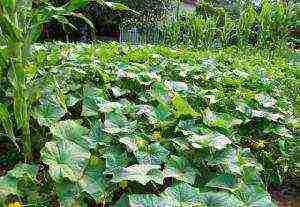
The sowing itself can be carried out in two ways: nest and row. The ordinary method involves planting seeds in several rows. The distance between seeds should be at least 10-15 centimeters. Later, when the plants grow up, you will need to remove the weak and thus increase the distance by 20-30 centimeters.The nesting method of sowing cucumber seeds is planting seeds in a hole. You can put 5-6 pieces in it. The distance between the seeds should be at least 20 centimeters so that the grown plants do not interfere with each other.
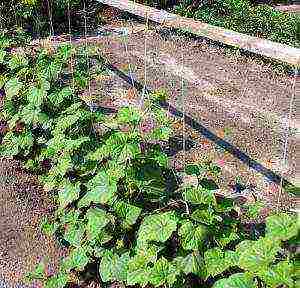
What are the best cucumber seeds - the opinions of gardeners
The question of which seeds of cucumbers are best to plant was asked by any novice gardener. And experienced ones answer that the choice of a variety depends on the conditions in which these vegetables will be grown. After all, each variety has certain advantages. Among the cucumbers planted in open ground, gardeners prefer the following varieties: "Farmer", "True Friends", "Lord". They are considered the most productive and belong to the category of bee-pollinated.

If there is a need to increase pollination, it is recommended to purchase colored seeds from which the pollinator plant grows. What are the best cucumber seeds for greenhouses? For these conditions, varieties that produce fruits without pollination (parthenocarpic) are better suited. Among these varieties of seeds are: "Marathon", "Relay", "Manual", "Northern Lights", "Olympiada" and "Ladoga".
Parthenocarpic seeds especially need favorable growing conditions, since any stress on the plant reduces the formation of ovaries.
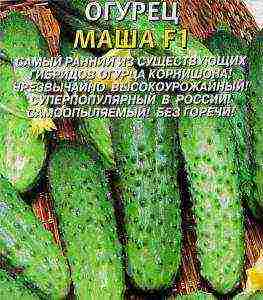
Cold-resistant varieties include cucumbers, adapted to sudden changes in temperature, to low air humidity. These are especially suitable for the climate of Siberia. The best varieties of cucumbers in this category: "Buyan", "Boy with a Thumb", "Balalaika", "Three Tankers", "Kozyrnaya Karta", "Saltan".
Cucumber seeds - the purpose of varieties
Cucumber varieties, in addition to the type of cultivation, are also distinguished by purpose. They are subdivided into pickling, salad, universal and canned foods. For pickled varieties, thick skin is characteristic. The fruits are saturated with sugars and pectin substances. What are the best pickled cucumber seeds? These are "Anyuta", "True Friends", "Saltan" and "Buyan". They have a fairly high yield.

For salad cucumbers, smooth fruits are characteristic, often lumpy, with an average size. They have a sweetish taste, do not contain any bitterness.... A particularly attractive quality is their crispy flesh. The best among salad cucumbers are Makar, Zozulya, Bazar, Bukhara and Tamerlane. Experienced gardeners recommend planting several varieties at once - even if some one does not meet your expectations, his neighbors in the garden will certainly delight with the harvest.
